Comprehensive Report: Health and Social Care Partnership Analysis
VerifiedAdded on 2020/02/05
|10
|2934
|23
Report
AI Summary
This report delves into the multifaceted realm of health and social care partnerships, offering a comprehensive analysis of their various aspects. It commences by elucidating the philosophical underpinnings of such collaborations, emphasizing the significance of trust, mutuality, empowerment, autonomy, respect, and power-sharing. The report then explores the diverse models of partnership, including formal, informal, collaborative, hybrid, and joint funding models, while also examining the relevant legislation governing these partnerships. Furthermore, it highlights the differences in working practices that can impact collaborative efforts, such as variations in organizational policies, record-keeping systems, and funding schemes. The report also assesses the outcomes of partnerships for service professionals and organizations, identifying both advantages, like increased efficiency, cost reduction, and standardization, and disadvantages, such as potential miscommunication and increased costs. Finally, it addresses potential barriers within the health and social care sector, including professional boundaries and communication challenges, and proposes strategies to enhance partnership outcomes, thereby contributing to improved service delivery and patient care.

Working in Partnership in
Health and Social Care
Health and Social Care
Paraphrase This Document
Need a fresh take? Get an instant paraphrase of this document with our AI Paraphraser
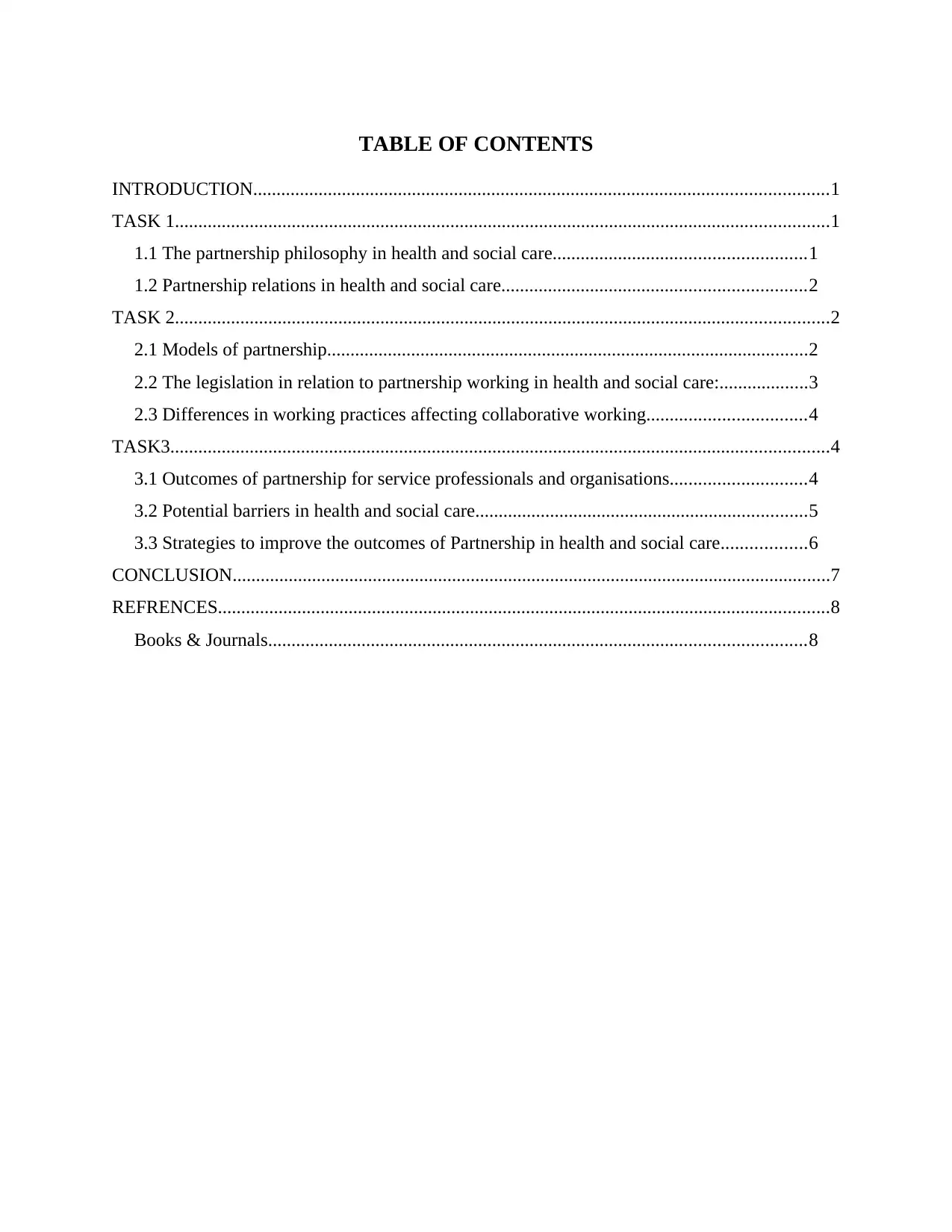
TABLE OF CONTENTS
INTRODUCTION...........................................................................................................................1
TASK 1............................................................................................................................................1
1.1 The partnership philosophy in health and social care......................................................1
1.2 Partnership relations in health and social care.................................................................2
TASK 2............................................................................................................................................2
2.1 Models of partnership.......................................................................................................2
2.2 The legislation in relation to partnership working in health and social care:...................3
2.3 Differences in working practices affecting collaborative working..................................4
TASK3.............................................................................................................................................4
3.1 Outcomes of partnership for service professionals and organisations.............................4
3.2 Potential barriers in health and social care.......................................................................5
3.3 Strategies to improve the outcomes of Partnership in health and social care..................6
CONCLUSION................................................................................................................................7
REFRENCES...................................................................................................................................8
Books & Journals...................................................................................................................8
INTRODUCTION...........................................................................................................................1
TASK 1............................................................................................................................................1
1.1 The partnership philosophy in health and social care......................................................1
1.2 Partnership relations in health and social care.................................................................2
TASK 2............................................................................................................................................2
2.1 Models of partnership.......................................................................................................2
2.2 The legislation in relation to partnership working in health and social care:...................3
2.3 Differences in working practices affecting collaborative working..................................4
TASK3.............................................................................................................................................4
3.1 Outcomes of partnership for service professionals and organisations.............................4
3.2 Potential barriers in health and social care.......................................................................5
3.3 Strategies to improve the outcomes of Partnership in health and social care..................6
CONCLUSION................................................................................................................................7
REFRENCES...................................................................................................................................8
Books & Journals...................................................................................................................8
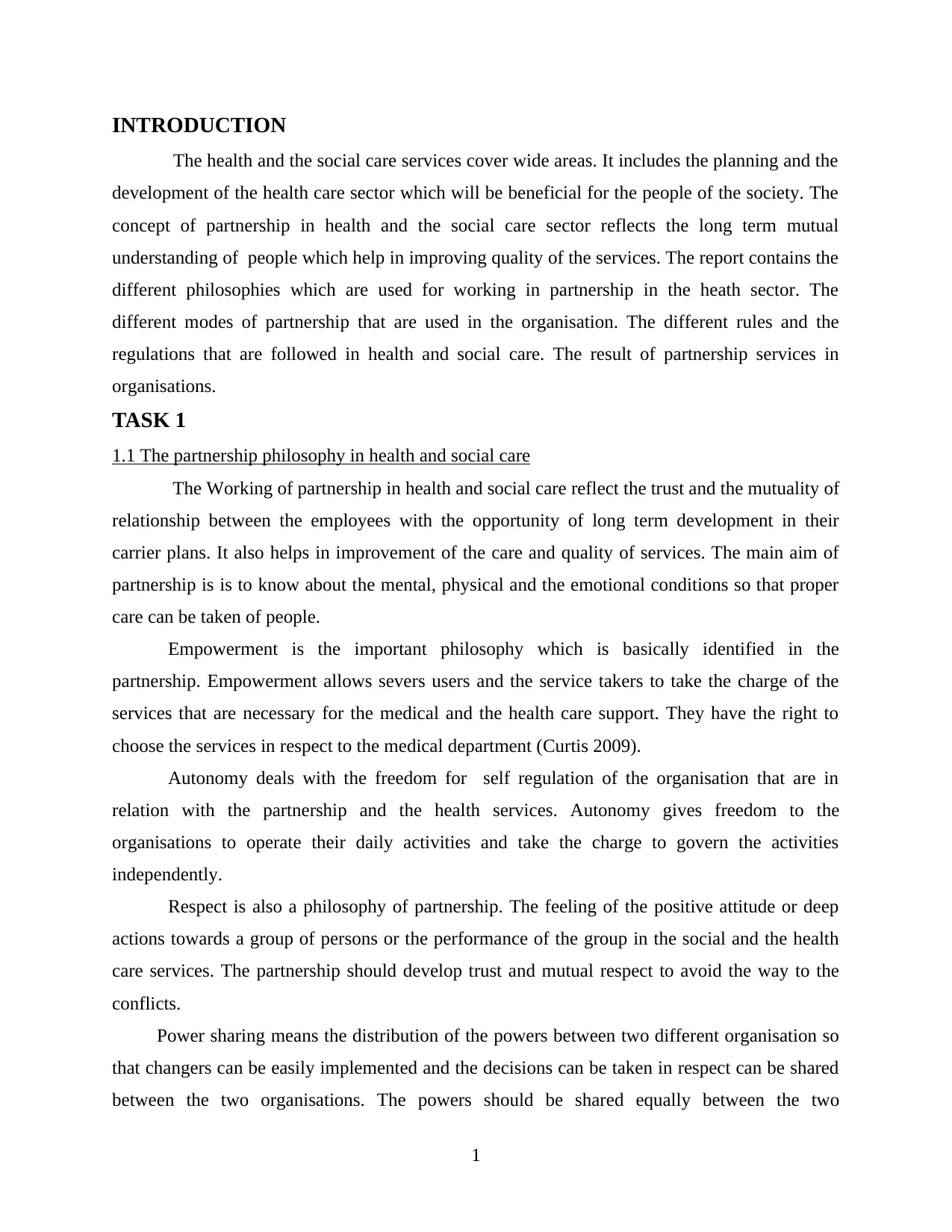
INTRODUCTION
The health and the social care services cover wide areas. It includes the planning and the
development of the health care sector which will be beneficial for the people of the society. The
concept of partnership in health and the social care sector reflects the long term mutual
understanding of people which help in improving quality of the services. The report contains the
different philosophies which are used for working in partnership in the heath sector. The
different modes of partnership that are used in the organisation. The different rules and the
regulations that are followed in health and social care. The result of partnership services in
organisations.
TASK 1
1.1 The partnership philosophy in health and social care
The Working of partnership in health and social care reflect the trust and the mutuality of
relationship between the employees with the opportunity of long term development in their
carrier plans. It also helps in improvement of the care and quality of services. The main aim of
partnership is is to know about the mental, physical and the emotional conditions so that proper
care can be taken of people.
Empowerment is the important philosophy which is basically identified in the
partnership. Empowerment allows severs users and the service takers to take the charge of the
services that are necessary for the medical and the health care support. They have the right to
choose the services in respect to the medical department (Curtis 2009).
Autonomy deals with the freedom for self regulation of the organisation that are in
relation with the partnership and the health services. Autonomy gives freedom to the
organisations to operate their daily activities and take the charge to govern the activities
independently.
Respect is also a philosophy of partnership. The feeling of the positive attitude or deep
actions towards a group of persons or the performance of the group in the social and the health
care services. The partnership should develop trust and mutual respect to avoid the way to the
conflicts.
Power sharing means the distribution of the powers between two different organisation so
that changers can be easily implemented and the decisions can be taken in respect can be shared
between the two organisations. The powers should be shared equally between the two
1
The health and the social care services cover wide areas. It includes the planning and the
development of the health care sector which will be beneficial for the people of the society. The
concept of partnership in health and the social care sector reflects the long term mutual
understanding of people which help in improving quality of the services. The report contains the
different philosophies which are used for working in partnership in the heath sector. The
different modes of partnership that are used in the organisation. The different rules and the
regulations that are followed in health and social care. The result of partnership services in
organisations.
TASK 1
1.1 The partnership philosophy in health and social care
The Working of partnership in health and social care reflect the trust and the mutuality of
relationship between the employees with the opportunity of long term development in their
carrier plans. It also helps in improvement of the care and quality of services. The main aim of
partnership is is to know about the mental, physical and the emotional conditions so that proper
care can be taken of people.
Empowerment is the important philosophy which is basically identified in the
partnership. Empowerment allows severs users and the service takers to take the charge of the
services that are necessary for the medical and the health care support. They have the right to
choose the services in respect to the medical department (Curtis 2009).
Autonomy deals with the freedom for self regulation of the organisation that are in
relation with the partnership and the health services. Autonomy gives freedom to the
organisations to operate their daily activities and take the charge to govern the activities
independently.
Respect is also a philosophy of partnership. The feeling of the positive attitude or deep
actions towards a group of persons or the performance of the group in the social and the health
care services. The partnership should develop trust and mutual respect to avoid the way to the
conflicts.
Power sharing means the distribution of the powers between two different organisation so
that changers can be easily implemented and the decisions can be taken in respect can be shared
between the two organisations. The powers should be shared equally between the two
1
⊘ This is a preview!⊘
Do you want full access?
Subscribe today to unlock all pages.

Trusted by 1+ million students worldwide
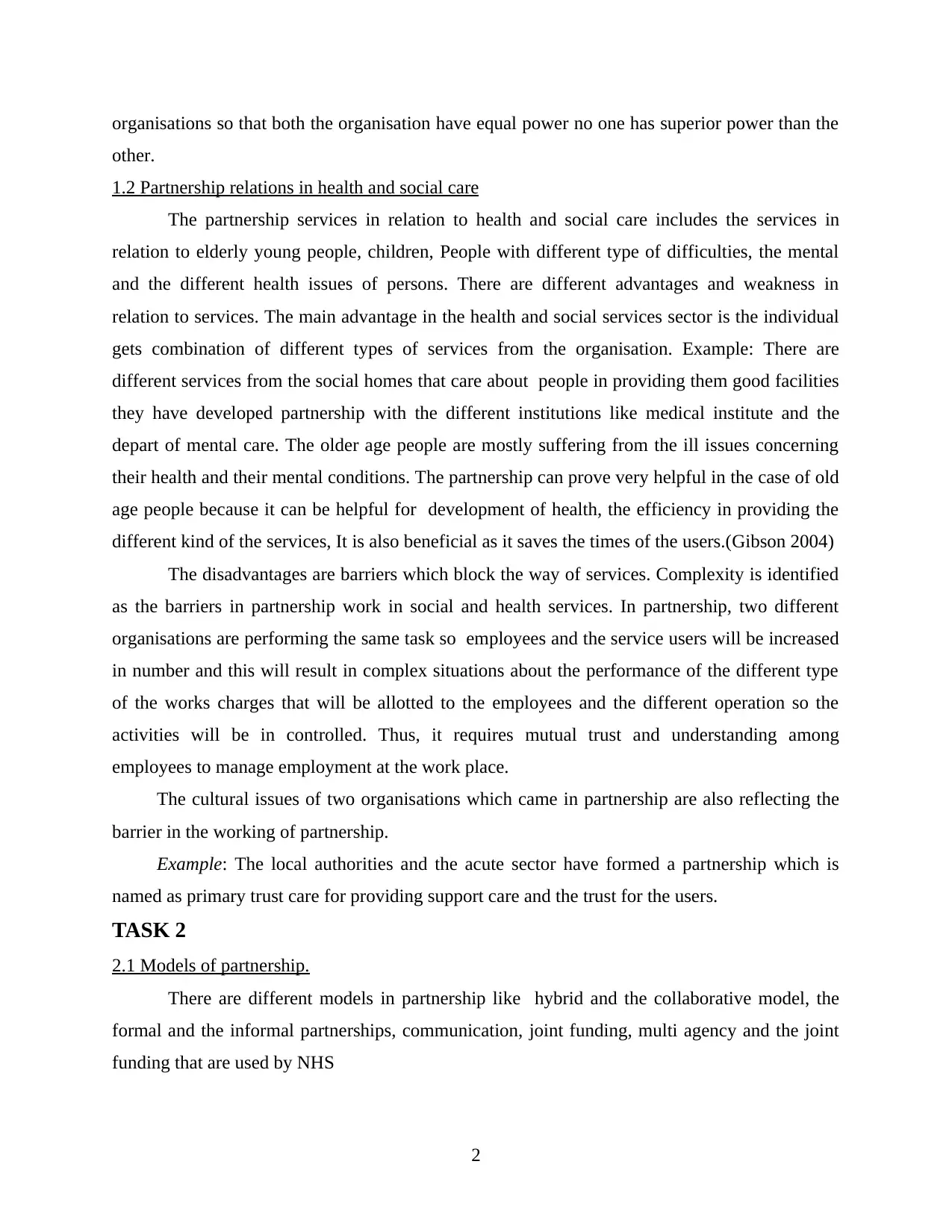
organisations so that both the organisation have equal power no one has superior power than the
other.
1.2 Partnership relations in health and social care
The partnership services in relation to health and social care includes the services in
relation to elderly young people, children, People with different type of difficulties, the mental
and the different health issues of persons. There are different advantages and weakness in
relation to services. The main advantage in the health and social services sector is the individual
gets combination of different types of services from the organisation. Example: There are
different services from the social homes that care about people in providing them good facilities
they have developed partnership with the different institutions like medical institute and the
depart of mental care. The older age people are mostly suffering from the ill issues concerning
their health and their mental conditions. The partnership can prove very helpful in the case of old
age people because it can be helpful for development of health, the efficiency in providing the
different kind of the services, It is also beneficial as it saves the times of the users.(Gibson 2004)
The disadvantages are barriers which block the way of services. Complexity is identified
as the barriers in partnership work in social and health services. In partnership, two different
organisations are performing the same task so employees and the service users will be increased
in number and this will result in complex situations about the performance of the different type
of the works charges that will be allotted to the employees and the different operation so the
activities will be in controlled. Thus, it requires mutual trust and understanding among
employees to manage employment at the work place.
The cultural issues of two organisations which came in partnership are also reflecting the
barrier in the working of partnership.
Example: The local authorities and the acute sector have formed a partnership which is
named as primary trust care for providing support care and the trust for the users.
TASK 2
2.1 Models of partnership.
There are different models in partnership like hybrid and the collaborative model, the
formal and the informal partnerships, communication, joint funding, multi agency and the joint
funding that are used by NHS
2
other.
1.2 Partnership relations in health and social care
The partnership services in relation to health and social care includes the services in
relation to elderly young people, children, People with different type of difficulties, the mental
and the different health issues of persons. There are different advantages and weakness in
relation to services. The main advantage in the health and social services sector is the individual
gets combination of different types of services from the organisation. Example: There are
different services from the social homes that care about people in providing them good facilities
they have developed partnership with the different institutions like medical institute and the
depart of mental care. The older age people are mostly suffering from the ill issues concerning
their health and their mental conditions. The partnership can prove very helpful in the case of old
age people because it can be helpful for development of health, the efficiency in providing the
different kind of the services, It is also beneficial as it saves the times of the users.(Gibson 2004)
The disadvantages are barriers which block the way of services. Complexity is identified
as the barriers in partnership work in social and health services. In partnership, two different
organisations are performing the same task so employees and the service users will be increased
in number and this will result in complex situations about the performance of the different type
of the works charges that will be allotted to the employees and the different operation so the
activities will be in controlled. Thus, it requires mutual trust and understanding among
employees to manage employment at the work place.
The cultural issues of two organisations which came in partnership are also reflecting the
barrier in the working of partnership.
Example: The local authorities and the acute sector have formed a partnership which is
named as primary trust care for providing support care and the trust for the users.
TASK 2
2.1 Models of partnership.
There are different models in partnership like hybrid and the collaborative model, the
formal and the informal partnerships, communication, joint funding, multi agency and the joint
funding that are used by NHS
2
Paraphrase This Document
Need a fresh take? Get an instant paraphrase of this document with our AI Paraphraser
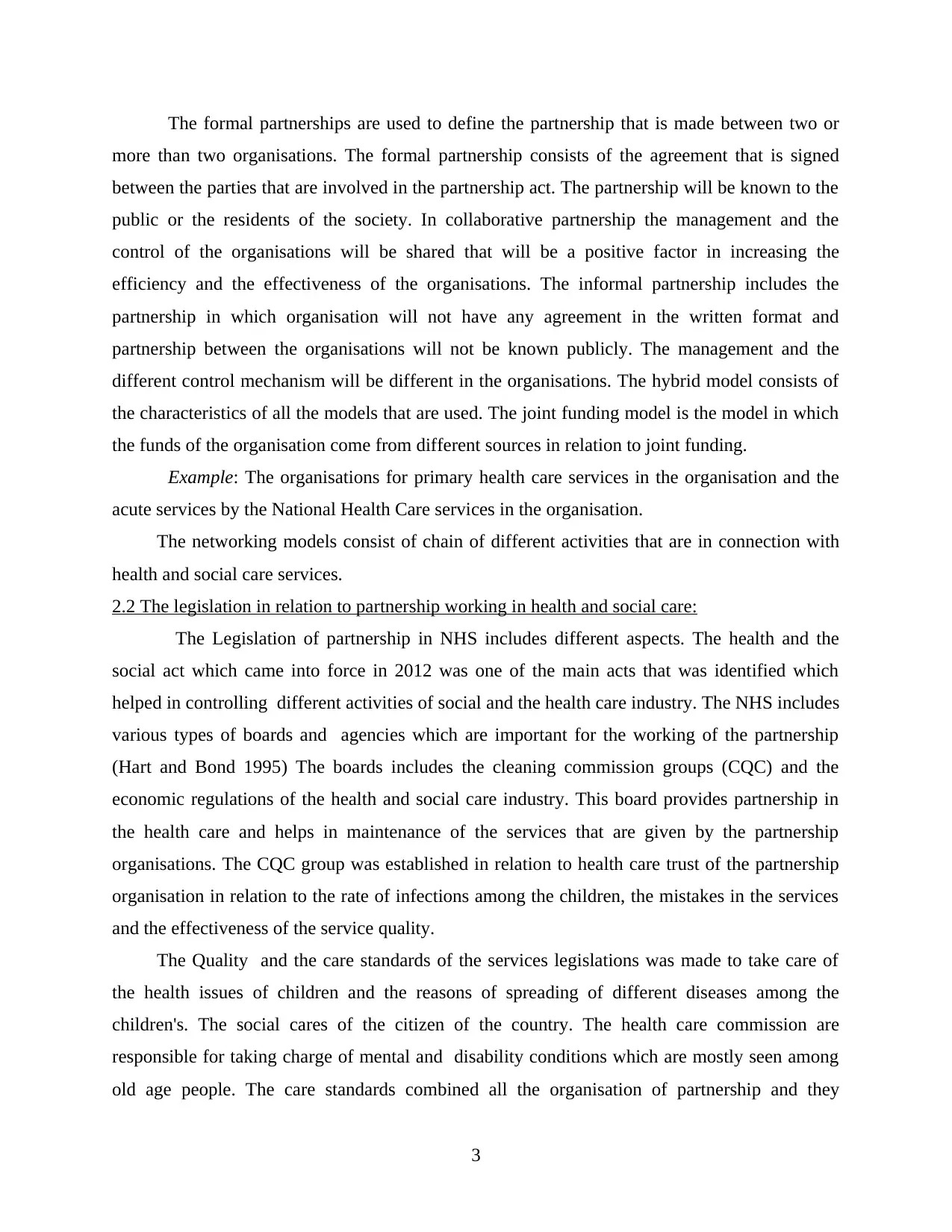
The formal partnerships are used to define the partnership that is made between two or
more than two organisations. The formal partnership consists of the agreement that is signed
between the parties that are involved in the partnership act. The partnership will be known to the
public or the residents of the society. In collaborative partnership the management and the
control of the organisations will be shared that will be a positive factor in increasing the
efficiency and the effectiveness of the organisations. The informal partnership includes the
partnership in which organisation will not have any agreement in the written format and
partnership between the organisations will not be known publicly. The management and the
different control mechanism will be different in the organisations. The hybrid model consists of
the characteristics of all the models that are used. The joint funding model is the model in which
the funds of the organisation come from different sources in relation to joint funding.
Example: The organisations for primary health care services in the organisation and the
acute services by the National Health Care services in the organisation.
The networking models consist of chain of different activities that are in connection with
health and social care services.
2.2 The legislation in relation to partnership working in health and social care:
The Legislation of partnership in NHS includes different aspects. The health and the
social act which came into force in 2012 was one of the main acts that was identified which
helped in controlling different activities of social and the health care industry. The NHS includes
various types of boards and agencies which are important for the working of the partnership
(Hart and Bond 1995) The boards includes the cleaning commission groups (CQC) and the
economic regulations of the health and social care industry. This board provides partnership in
the health care and helps in maintenance of the services that are given by the partnership
organisations. The CQC group was established in relation to health care trust of the partnership
organisation in relation to the rate of infections among the children, the mistakes in the services
and the effectiveness of the service quality.
The Quality and the care standards of the services legislations was made to take care of
the health issues of children and the reasons of spreading of different diseases among the
children's. The social cares of the citizen of the country. The health care commission are
responsible for taking charge of mental and disability conditions which are mostly seen among
old age people. The care standards combined all the organisation of partnership and they
3
more than two organisations. The formal partnership consists of the agreement that is signed
between the parties that are involved in the partnership act. The partnership will be known to the
public or the residents of the society. In collaborative partnership the management and the
control of the organisations will be shared that will be a positive factor in increasing the
efficiency and the effectiveness of the organisations. The informal partnership includes the
partnership in which organisation will not have any agreement in the written format and
partnership between the organisations will not be known publicly. The management and the
different control mechanism will be different in the organisations. The hybrid model consists of
the characteristics of all the models that are used. The joint funding model is the model in which
the funds of the organisation come from different sources in relation to joint funding.
Example: The organisations for primary health care services in the organisation and the
acute services by the National Health Care services in the organisation.
The networking models consist of chain of different activities that are in connection with
health and social care services.
2.2 The legislation in relation to partnership working in health and social care:
The Legislation of partnership in NHS includes different aspects. The health and the
social act which came into force in 2012 was one of the main acts that was identified which
helped in controlling different activities of social and the health care industry. The NHS includes
various types of boards and agencies which are important for the working of the partnership
(Hart and Bond 1995) The boards includes the cleaning commission groups (CQC) and the
economic regulations of the health and social care industry. This board provides partnership in
the health care and helps in maintenance of the services that are given by the partnership
organisations. The CQC group was established in relation to health care trust of the partnership
organisation in relation to the rate of infections among the children, the mistakes in the services
and the effectiveness of the service quality.
The Quality and the care standards of the services legislations was made to take care of
the health issues of children and the reasons of spreading of different diseases among the
children's. The social cares of the citizen of the country. The health care commission are
responsible for taking charge of mental and disability conditions which are mostly seen among
old age people. The care standards combined all the organisation of partnership and they
3
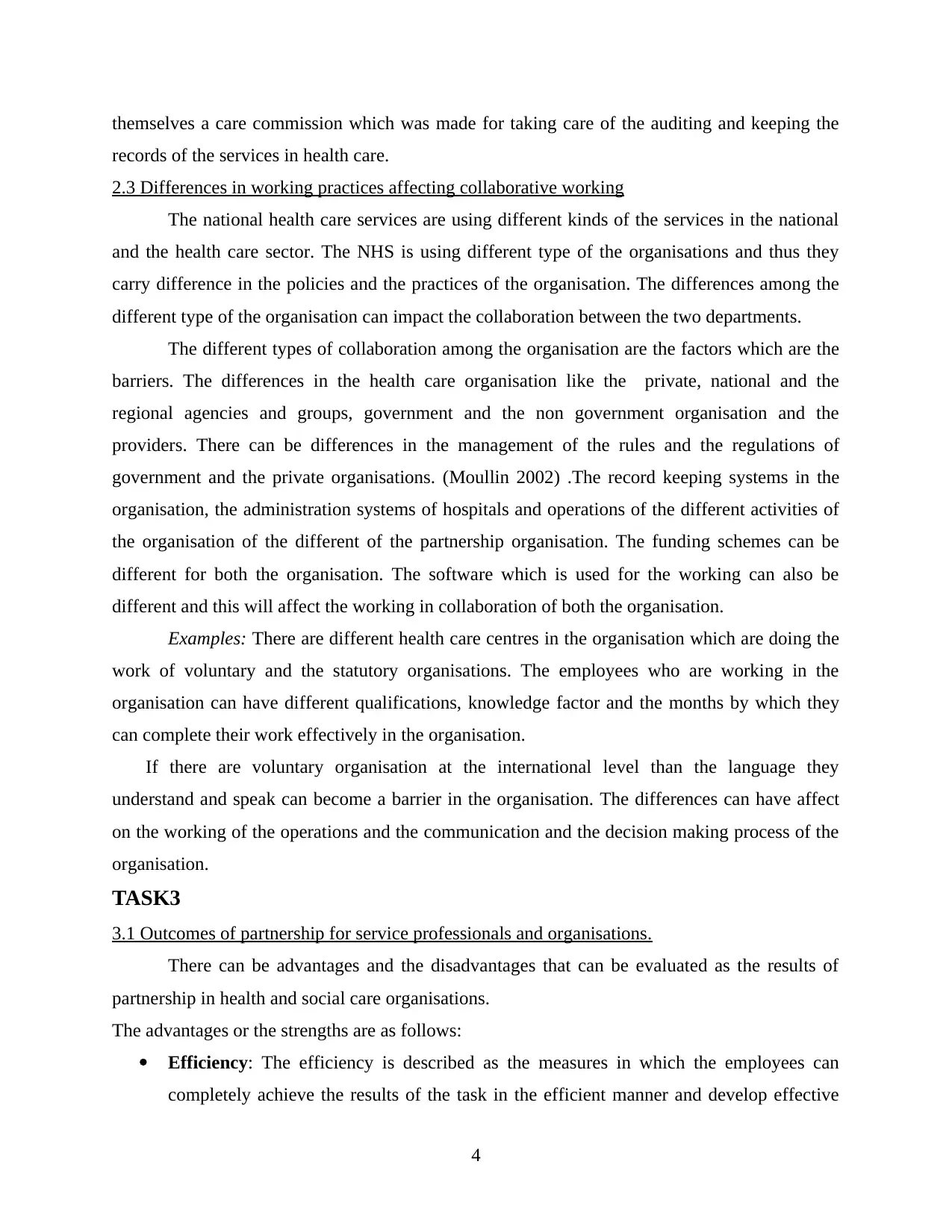
themselves a care commission which was made for taking care of the auditing and keeping the
records of the services in health care.
2.3 Differences in working practices affecting collaborative working
The national health care services are using different kinds of the services in the national
and the health care sector. The NHS is using different type of the organisations and thus they
carry difference in the policies and the practices of the organisation. The differences among the
different type of the organisation can impact the collaboration between the two departments.
The different types of collaboration among the organisation are the factors which are the
barriers. The differences in the health care organisation like the private, national and the
regional agencies and groups, government and the non government organisation and the
providers. There can be differences in the management of the rules and the regulations of
government and the private organisations. (Moullin 2002) .The record keeping systems in the
organisation, the administration systems of hospitals and operations of the different activities of
the organisation of the different of the partnership organisation. The funding schemes can be
different for both the organisation. The software which is used for the working can also be
different and this will affect the working in collaboration of both the organisation.
Examples: There are different health care centres in the organisation which are doing the
work of voluntary and the statutory organisations. The employees who are working in the
organisation can have different qualifications, knowledge factor and the months by which they
can complete their work effectively in the organisation.
If there are voluntary organisation at the international level than the language they
understand and speak can become a barrier in the organisation. The differences can have affect
on the working of the operations and the communication and the decision making process of the
organisation.
TASK3
3.1 Outcomes of partnership for service professionals and organisations.
There can be advantages and the disadvantages that can be evaluated as the results of
partnership in health and social care organisations.
The advantages or the strengths are as follows:
Efficiency: The efficiency is described as the measures in which the employees can
completely achieve the results of the task in the efficient manner and develop effective
4
records of the services in health care.
2.3 Differences in working practices affecting collaborative working
The national health care services are using different kinds of the services in the national
and the health care sector. The NHS is using different type of the organisations and thus they
carry difference in the policies and the practices of the organisation. The differences among the
different type of the organisation can impact the collaboration between the two departments.
The different types of collaboration among the organisation are the factors which are the
barriers. The differences in the health care organisation like the private, national and the
regional agencies and groups, government and the non government organisation and the
providers. There can be differences in the management of the rules and the regulations of
government and the private organisations. (Moullin 2002) .The record keeping systems in the
organisation, the administration systems of hospitals and operations of the different activities of
the organisation of the different of the partnership organisation. The funding schemes can be
different for both the organisation. The software which is used for the working can also be
different and this will affect the working in collaboration of both the organisation.
Examples: There are different health care centres in the organisation which are doing the
work of voluntary and the statutory organisations. The employees who are working in the
organisation can have different qualifications, knowledge factor and the months by which they
can complete their work effectively in the organisation.
If there are voluntary organisation at the international level than the language they
understand and speak can become a barrier in the organisation. The differences can have affect
on the working of the operations and the communication and the decision making process of the
organisation.
TASK3
3.1 Outcomes of partnership for service professionals and organisations.
There can be advantages and the disadvantages that can be evaluated as the results of
partnership in health and social care organisations.
The advantages or the strengths are as follows:
Efficiency: The efficiency is described as the measures in which the employees can
completely achieve the results of the task in the efficient manner and develop effective
4
⊘ This is a preview!⊘
Do you want full access?
Subscribe today to unlock all pages.

Trusted by 1+ million students worldwide
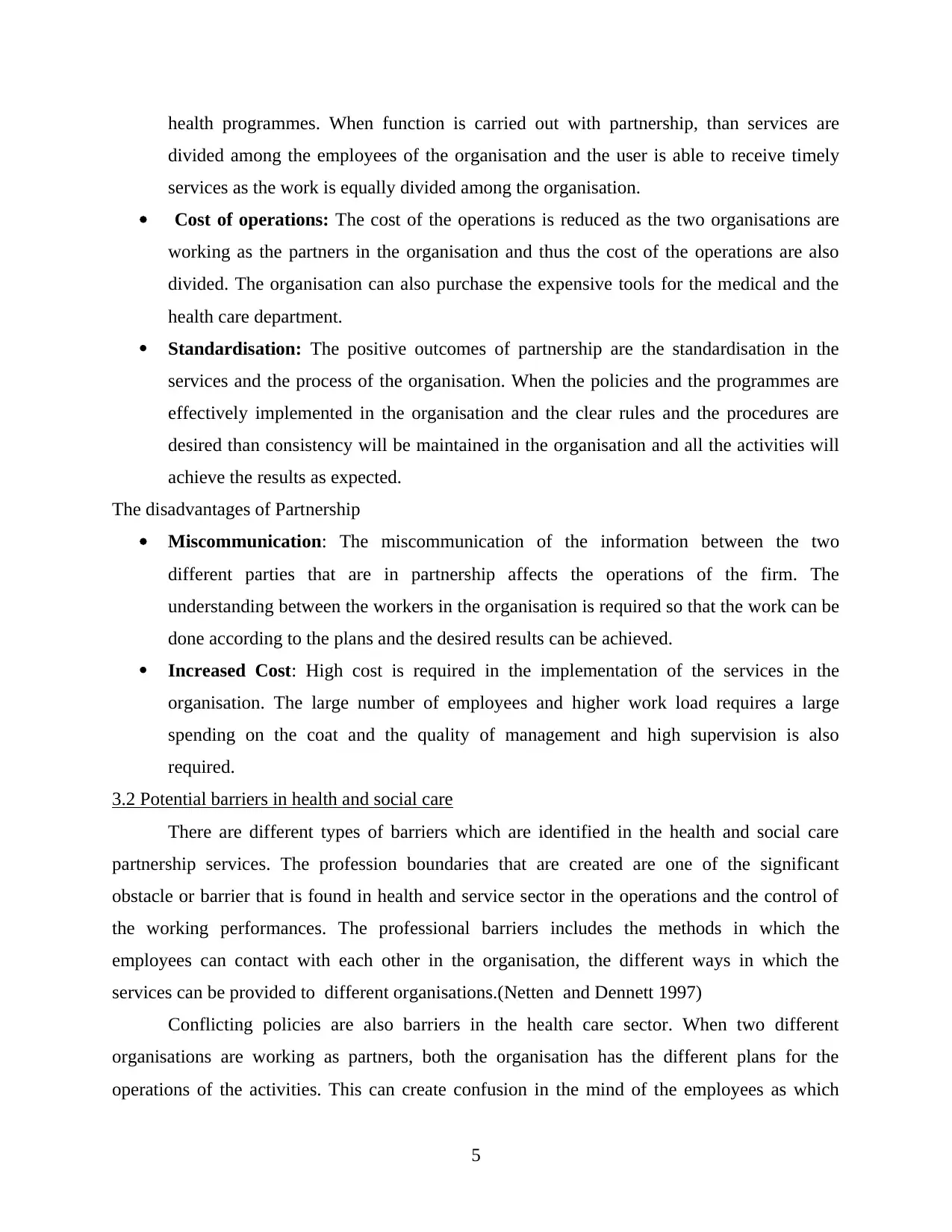
health programmes. When function is carried out with partnership, than services are
divided among the employees of the organisation and the user is able to receive timely
services as the work is equally divided among the organisation.
Cost of operations: The cost of the operations is reduced as the two organisations are
working as the partners in the organisation and thus the cost of the operations are also
divided. The organisation can also purchase the expensive tools for the medical and the
health care department.
Standardisation: The positive outcomes of partnership are the standardisation in the
services and the process of the organisation. When the policies and the programmes are
effectively implemented in the organisation and the clear rules and the procedures are
desired than consistency will be maintained in the organisation and all the activities will
achieve the results as expected.
The disadvantages of Partnership
Miscommunication: The miscommunication of the information between the two
different parties that are in partnership affects the operations of the firm. The
understanding between the workers in the organisation is required so that the work can be
done according to the plans and the desired results can be achieved.
Increased Cost: High cost is required in the implementation of the services in the
organisation. The large number of employees and higher work load requires a large
spending on the coat and the quality of management and high supervision is also
required.
3.2 Potential barriers in health and social care
There are different types of barriers which are identified in the health and social care
partnership services. The profession boundaries that are created are one of the significant
obstacle or barrier that is found in health and service sector in the operations and the control of
the working performances. The professional barriers includes the methods in which the
employees can contact with each other in the organisation, the different ways in which the
services can be provided to different organisations.(Netten and Dennett 1997)
Conflicting policies are also barriers in the health care sector. When two different
organisations are working as partners, both the organisation has the different plans for the
operations of the activities. This can create confusion in the mind of the employees as which
5
divided among the employees of the organisation and the user is able to receive timely
services as the work is equally divided among the organisation.
Cost of operations: The cost of the operations is reduced as the two organisations are
working as the partners in the organisation and thus the cost of the operations are also
divided. The organisation can also purchase the expensive tools for the medical and the
health care department.
Standardisation: The positive outcomes of partnership are the standardisation in the
services and the process of the organisation. When the policies and the programmes are
effectively implemented in the organisation and the clear rules and the procedures are
desired than consistency will be maintained in the organisation and all the activities will
achieve the results as expected.
The disadvantages of Partnership
Miscommunication: The miscommunication of the information between the two
different parties that are in partnership affects the operations of the firm. The
understanding between the workers in the organisation is required so that the work can be
done according to the plans and the desired results can be achieved.
Increased Cost: High cost is required in the implementation of the services in the
organisation. The large number of employees and higher work load requires a large
spending on the coat and the quality of management and high supervision is also
required.
3.2 Potential barriers in health and social care
There are different types of barriers which are identified in the health and social care
partnership services. The profession boundaries that are created are one of the significant
obstacle or barrier that is found in health and service sector in the operations and the control of
the working performances. The professional barriers includes the methods in which the
employees can contact with each other in the organisation, the different ways in which the
services can be provided to different organisations.(Netten and Dennett 1997)
Conflicting policies are also barriers in the health care sector. When two different
organisations are working as partners, both the organisation has the different plans for the
operations of the activities. This can create confusion in the mind of the employees as which
5
Paraphrase This Document
Need a fresh take? Get an instant paraphrase of this document with our AI Paraphraser
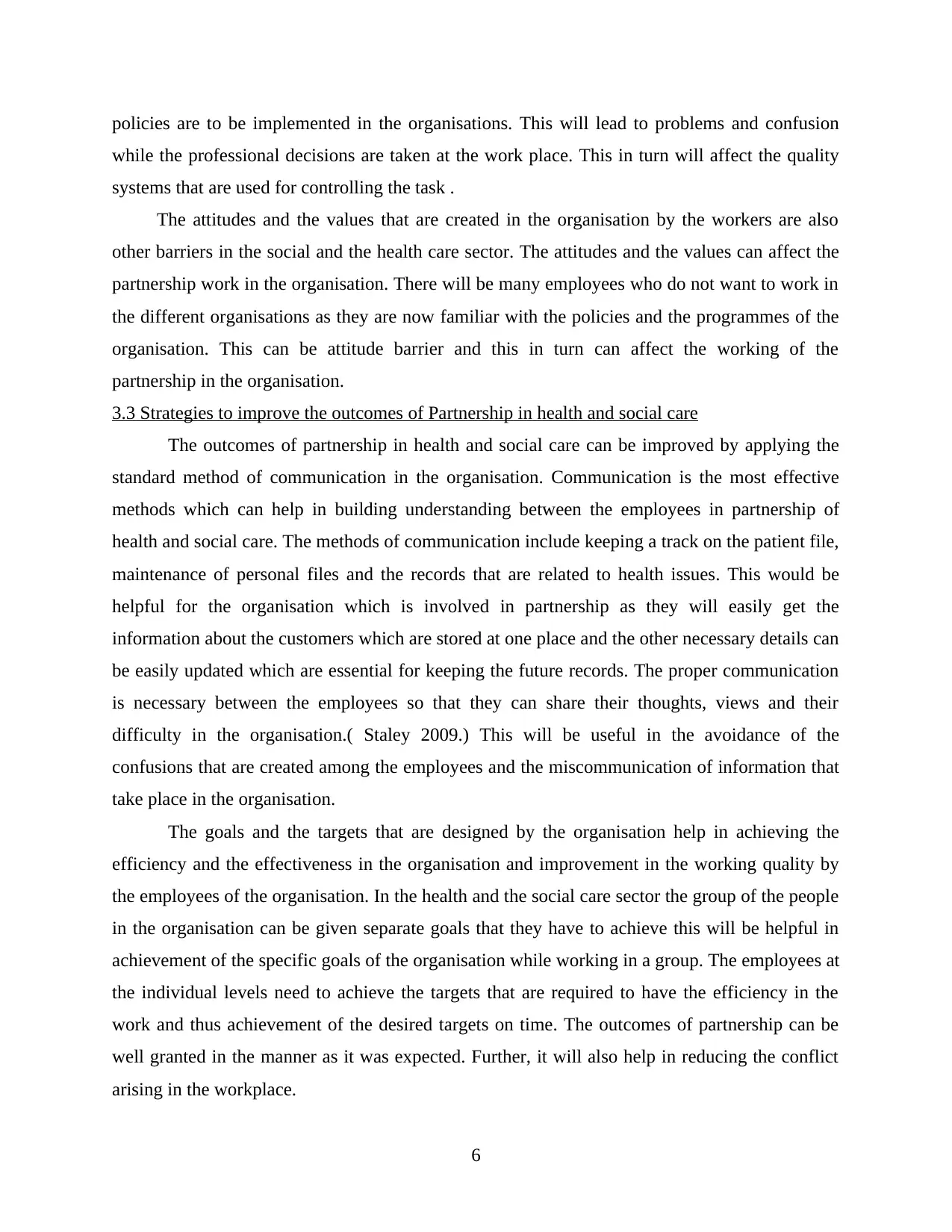
policies are to be implemented in the organisations. This will lead to problems and confusion
while the professional decisions are taken at the work place. This in turn will affect the quality
systems that are used for controlling the task .
The attitudes and the values that are created in the organisation by the workers are also
other barriers in the social and the health care sector. The attitudes and the values can affect the
partnership work in the organisation. There will be many employees who do not want to work in
the different organisations as they are now familiar with the policies and the programmes of the
organisation. This can be attitude barrier and this in turn can affect the working of the
partnership in the organisation.
3.3 Strategies to improve the outcomes of Partnership in health and social care
The outcomes of partnership in health and social care can be improved by applying the
standard method of communication in the organisation. Communication is the most effective
methods which can help in building understanding between the employees in partnership of
health and social care. The methods of communication include keeping a track on the patient file,
maintenance of personal files and the records that are related to health issues. This would be
helpful for the organisation which is involved in partnership as they will easily get the
information about the customers which are stored at one place and the other necessary details can
be easily updated which are essential for keeping the future records. The proper communication
is necessary between the employees so that they can share their thoughts, views and their
difficulty in the organisation.( Staley 2009.) This will be useful in the avoidance of the
confusions that are created among the employees and the miscommunication of information that
take place in the organisation.
The goals and the targets that are designed by the organisation help in achieving the
efficiency and the effectiveness in the organisation and improvement in the working quality by
the employees of the organisation. In the health and the social care sector the group of the people
in the organisation can be given separate goals that they have to achieve this will be helpful in
achievement of the specific goals of the organisation while working in a group. The employees at
the individual levels need to achieve the targets that are required to have the efficiency in the
work and thus achievement of the desired targets on time. The outcomes of partnership can be
well granted in the manner as it was expected. Further, it will also help in reducing the conflict
arising in the workplace.
6
while the professional decisions are taken at the work place. This in turn will affect the quality
systems that are used for controlling the task .
The attitudes and the values that are created in the organisation by the workers are also
other barriers in the social and the health care sector. The attitudes and the values can affect the
partnership work in the organisation. There will be many employees who do not want to work in
the different organisations as they are now familiar with the policies and the programmes of the
organisation. This can be attitude barrier and this in turn can affect the working of the
partnership in the organisation.
3.3 Strategies to improve the outcomes of Partnership in health and social care
The outcomes of partnership in health and social care can be improved by applying the
standard method of communication in the organisation. Communication is the most effective
methods which can help in building understanding between the employees in partnership of
health and social care. The methods of communication include keeping a track on the patient file,
maintenance of personal files and the records that are related to health issues. This would be
helpful for the organisation which is involved in partnership as they will easily get the
information about the customers which are stored at one place and the other necessary details can
be easily updated which are essential for keeping the future records. The proper communication
is necessary between the employees so that they can share their thoughts, views and their
difficulty in the organisation.( Staley 2009.) This will be useful in the avoidance of the
confusions that are created among the employees and the miscommunication of information that
take place in the organisation.
The goals and the targets that are designed by the organisation help in achieving the
efficiency and the effectiveness in the organisation and improvement in the working quality by
the employees of the organisation. In the health and the social care sector the group of the people
in the organisation can be given separate goals that they have to achieve this will be helpful in
achievement of the specific goals of the organisation while working in a group. The employees at
the individual levels need to achieve the targets that are required to have the efficiency in the
work and thus achievement of the desired targets on time. The outcomes of partnership can be
well granted in the manner as it was expected. Further, it will also help in reducing the conflict
arising in the workplace.
6
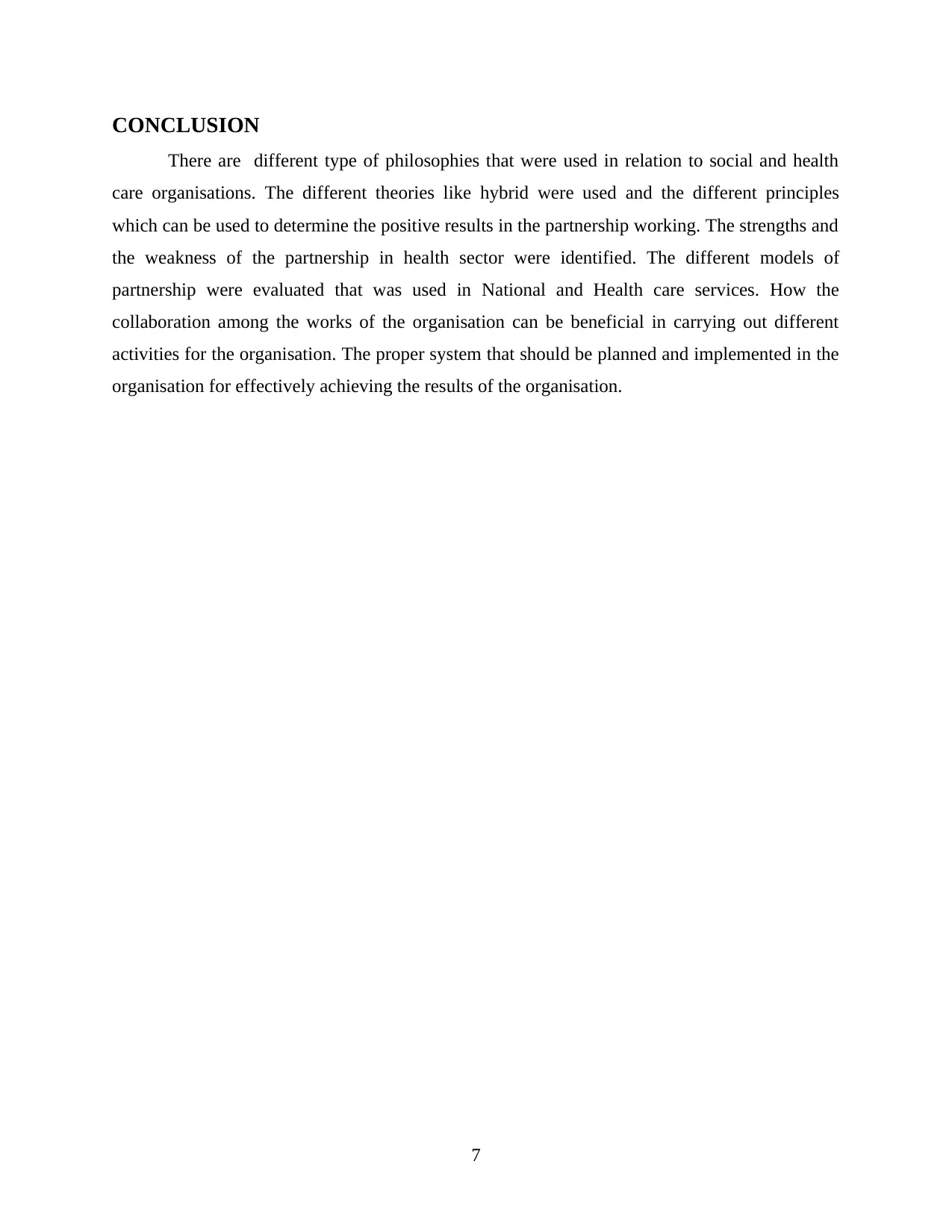
CONCLUSION
There are different type of philosophies that were used in relation to social and health
care organisations. The different theories like hybrid were used and the different principles
which can be used to determine the positive results in the partnership working. The strengths and
the weakness of the partnership in health sector were identified. The different models of
partnership were evaluated that was used in National and Health care services. How the
collaboration among the works of the organisation can be beneficial in carrying out different
activities for the organisation. The proper system that should be planned and implemented in the
organisation for effectively achieving the results of the organisation.
7
There are different type of philosophies that were used in relation to social and health
care organisations. The different theories like hybrid were used and the different principles
which can be used to determine the positive results in the partnership working. The strengths and
the weakness of the partnership in health sector were identified. The different models of
partnership were evaluated that was used in National and Health care services. How the
collaboration among the works of the organisation can be beneficial in carrying out different
activities for the organisation. The proper system that should be planned and implemented in the
organisation for effectively achieving the results of the organisation.
7
⊘ This is a preview!⊘
Do you want full access?
Subscribe today to unlock all pages.

Trusted by 1+ million students worldwide

REFRENCES
Books & Journals
Curtis, L.A., 2009.Unit costs of health and social care 2009. Personal Social Services Research
Unit, University of Kent.
Gibson, F., 2004. The past in the present: Using reminiscence in health and social care. Health
professions press.
Hart, F and Bond, M., 1995. Action research for health and social care: A guide to practice.
McGraw-Hill Education (UK).
Moullin, M., 2002. Delivering excellence in health and social care: Quality, excellence and
performance measurement. In Delivering excellence in health and social care: quality,
excellence and performance measurement.
Netten, A.P and Dennett, J.H., 1997. Unit costs of health and social care 1997.
Staley, K., 2009. Exploring Impact: Public involvement in NHS, public health and social care
research. National Institute for Health Research.
8
Books & Journals
Curtis, L.A., 2009.Unit costs of health and social care 2009. Personal Social Services Research
Unit, University of Kent.
Gibson, F., 2004. The past in the present: Using reminiscence in health and social care. Health
professions press.
Hart, F and Bond, M., 1995. Action research for health and social care: A guide to practice.
McGraw-Hill Education (UK).
Moullin, M., 2002. Delivering excellence in health and social care: Quality, excellence and
performance measurement. In Delivering excellence in health and social care: quality,
excellence and performance measurement.
Netten, A.P and Dennett, J.H., 1997. Unit costs of health and social care 1997.
Staley, K., 2009. Exploring Impact: Public involvement in NHS, public health and social care
research. National Institute for Health Research.
8
1 out of 10
Related Documents
Your All-in-One AI-Powered Toolkit for Academic Success.
+13062052269
info@desklib.com
Available 24*7 on WhatsApp / Email
![[object Object]](/_next/static/media/star-bottom.7253800d.svg)
Unlock your academic potential
Copyright © 2020–2025 A2Z Services. All Rights Reserved. Developed and managed by ZUCOL.





